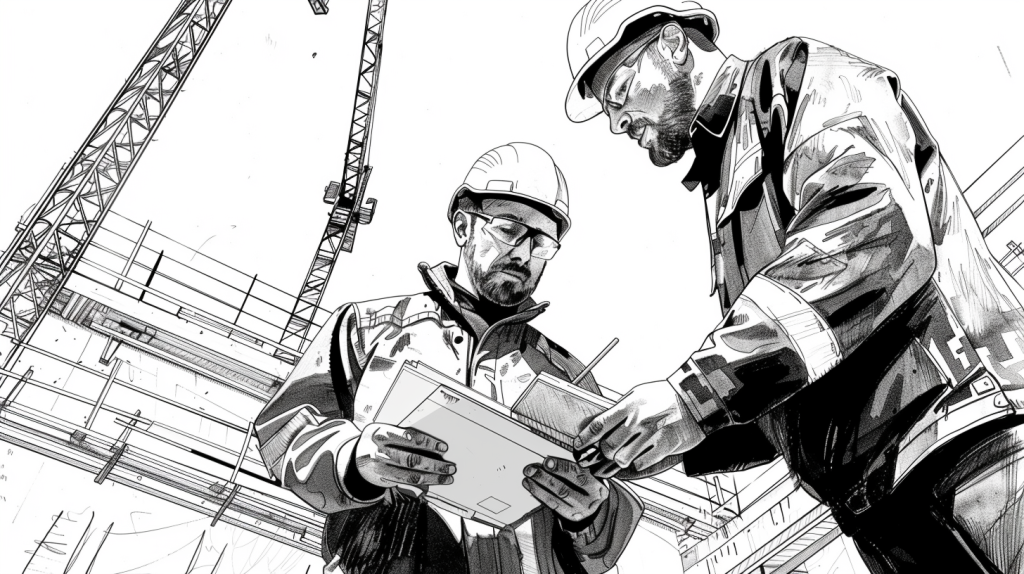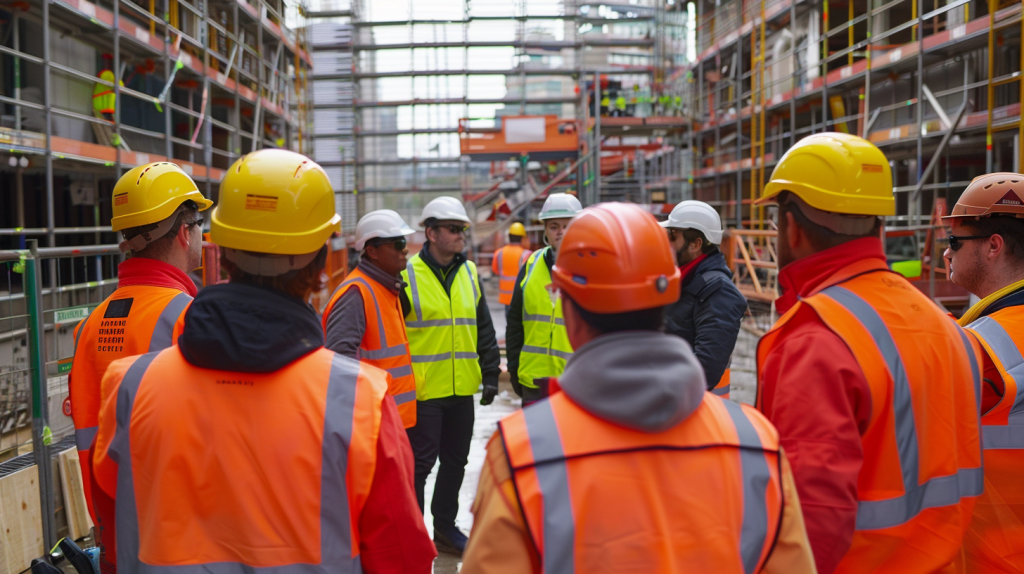Construction Compliance and Safety: Mastering Essential Tools and Best Practices for a Secure Construction Work Environment
Table of Contents:

Discover how to ensure compliance and safety in construction projects by mastering essential tools and best practices. Learn how to implement effective safety protocols, compliance tracking, and incident reporting to create a safe and regulatory-compliant work environment.
In the high-stakes world of construction, ensuring compliance and safety is not just a regulatory requirement—it’s a moral and practical necessity. Accidents, safety violations, and non-compliance with regulations can lead to severe consequences, including legal penalties, project delays, and, most importantly, harm to workers. Therefore, creating a secure work environment is paramount for successful construction project management.
By mastering essential tools and best practices, construction managers can effectively implement safety protocols, track compliance, and report incidents, thereby fostering a safe and compliant work environment. This comprehensive guide explores how to achieve these goals, highlighting the importance of compliance and safety in construction and providing actionable strategies and tools for implementation.
The Importance of Compliance and Safety in Construction
Reducing Risks and Preventing Accidents
Ensuring compliance with safety regulations and standards significantly reduces the risk of accidents and injuries on construction sites. Safety protocols are designed to protect workers from hazards such as falls, equipment malfunctions, and exposure to harmful substances. By strictly adhering to these protocols, construction managers can create a safer work environment.
For example, using personal protective equipment (PPE), implementing fall protection systems, and conducting regular safety training are critical measures that prevent common construction site accidents. These proactive steps not only protect workers but also minimize disruptions to the project timeline and budget caused by accidents.
Avoiding Legal Penalties
Non-compliance with safety regulations can result in severe legal penalties, including fines, project shutdowns, and even criminal charges in extreme cases. Regulatory bodies, such as the Occupational Safety and Health Administration (OSHA), set strict guidelines that construction companies must follow to ensure worker safety. Regular compliance checks and audits help avoid these legal repercussions and demonstrate a commitment to maintaining a safe work environment.
Enhancing Reputation and Trust
A strong safety record enhances a construction company’s reputation and builds trust with clients, stakeholders, and workers. Clients are more likely to engage with companies that prioritize safety and compliance, knowing that their projects will be managed responsibly. Workers, too, are more likely to stay with and perform well for companies that ensure their safety and well-being.
Essential Tools for Ensuring Compliance and Safety

StruxHub
Experience the power of StruxHub today and witness firsthand how it can revolutionize your construction operations.
Safety Management Software
Features and Benefits
Safety management software is a crucial tool for managing safety protocols and compliance tracking on construction sites. These platforms offer features such as incident reporting, safety audits, and training management, all accessible from a centralized system.
For instance, StruxHub’s safety management features allow construction managers to log incidents, track safety training, and conduct regular safety audits. This software helps ensure that all safety measures are documented and monitored, providing real-time insights into the safety status of the project.
Compliance Tracking Tools
Streamlining Regulatory Adherence
Compliance tracking tools help construction managers monitor adherence to safety regulations and standards. These tools can track various compliance metrics, generate reports, and alert managers to potential violations, ensuring that corrective actions are taken promptly.
By integrating compliance tracking tools with project management software, such as StruxHub, construction teams can maintain up-to-date records of compliance status, streamline audits, and reduce the risk of non-compliance.
Incident Reporting Systems
Ensuring Prompt Response
Incident reporting systems enable quick and efficient documentation of accidents and near-misses on construction sites. These systems allow workers to report incidents in real-time, providing essential details that help managers investigate and address the root causes.
For example, using mobile apps or online portals, workers can submit incident reports that include photos, descriptions, and witness accounts. This immediate reporting ensures that incidents are addressed promptly, preventing recurrence and improving overall site safety.
Training Management Platforms
Building a Safety-Conscious Workforce
Training management platforms are essential for ensuring that all workers receive the necessary safety training. These platforms can schedule training sessions, track completion, and provide certifications, ensuring that all workers are knowledgeable about safety protocols and regulations.
By using platforms like StruxHub, construction managers can ensure that all team members are trained regularly, maintaining a high level of safety awareness and compliance on the site.
Best Practices for Ensuring Compliance and Safety

Implementing Comprehensive Safety Protocols
Developing and Enforcing Guidelines
Developing comprehensive safety protocols is the first step toward ensuring a secure work environment. These protocols should cover all aspects of construction site safety, including PPE requirements, equipment operation guidelines, and emergency procedures.
Once developed, it is crucial to enforce these protocols consistently. Regular safety audits, conducted using tools like StruxHub, help identify areas of improvement and ensure that all team members adhere to the guidelines. Enforcing safety protocols diligently reduces the risk of accidents and fosters a culture of safety.
Conducting Regular Safety Audits
Identifying and Addressing Hazards
Regular safety audits are essential for identifying potential hazards and ensuring compliance with safety regulations. These audits involve inspecting the construction site, reviewing safety procedures, and interviewing workers to identify areas where safety protocols may be lacking.
By conducting regular audits, construction managers can proactively address hazards before they lead to accidents. Safety management software can facilitate these audits by providing checklists, tracking audit results, and generating reports for continuous improvement.
Providing Ongoing Safety Training
Keeping Workers Informed and Prepared
Ongoing safety training is crucial for keeping workers informed about the latest safety protocols and practices. Training sessions should be conducted regularly and cover a range of topics, including hazard recognition, emergency response, and proper use of PPE.
Using training management platforms, construction managers can schedule training sessions, track attendance, and ensure that all workers complete the required training. Regular training sessions help maintain a high level of safety awareness and preparedness among workers.
Encouraging Open Communication
Promoting a Safety-First Culture
Encouraging open communication about safety concerns is vital for creating a secure work environment. Workers should feel comfortable reporting hazards, near-misses, and unsafe practices without fear of retaliation.
By fostering a culture of open communication, construction managers can ensure that potential safety issues are identified and addressed promptly. Regular safety meetings, suggestion boxes, and anonymous reporting systems can facilitate this open communication.
Real-World Applications of Compliance and Safety Tools

Improving Site Safety with StruxHub
StruxHub’s comprehensive safety management features have been instrumental in improving site safety for numerous construction projects. By providing real-time insights, incident reporting, and compliance tracking, StruxHub enables construction managers to maintain high safety standards and ensure regulatory compliance.
Streamlining Compliance Tracking
Integrating compliance tracking tools with project management software helps streamline regulatory adherence and reduce the risk of non-compliance. For instance, a construction company using StruxHub’s compliance tracking features can monitor compliance metrics, generate reports, and receive alerts about potential violations, ensuring timely corrective actions.
Enhancing Incident Reporting and Response
Incident reporting systems are crucial for ensuring prompt response to accidents and near-misses. By enabling real-time reporting, these systems help construction managers investigate incidents quickly and implement measures to prevent recurrence.
For example, using mobile apps for incident reporting allows workers to submit detailed reports immediately after an incident occurs. This immediate documentation facilitates swift investigation and resolution, improving overall site safety.
Top 12 Tips for Ensuring Compliance and Safety in Construction
1. Develop Comprehensive Safety Protocols
Create detailed safety protocols covering all aspects of site safety, including PPE requirements, equipment operation, and emergency procedures. Ensure that these protocols are communicated to all workers and enforced consistently.
2. Conduct Regular Safety Audits
Schedule regular safety audits to identify potential hazards and ensure compliance with safety regulations. Use safety management software to track audit results and implement corrective actions.
3. Provide Ongoing Safety Training
Ensure that all workers receive regular safety training covering a range of topics, including hazard recognition, emergency response, and proper use of PPE. Use training management platforms to schedule and track training sessions.
4. Implement Incident Reporting Systems
Enable real-time incident reporting using mobile apps or online portals. Ensure that all incidents and near-misses are documented promptly and investigated thoroughly.
5. Use Compliance Tracking Tools
Integrate compliance tracking tools with project management software to monitor adherence to safety regulations and standards. Generate regular compliance reports and address any potential violations promptly.
6. Foster Open Communication
Encourage workers to report safety concerns, hazards, and near-misses without fear of retaliation. Promote a culture of open communication through regular safety meetings, suggestion boxes, and anonymous reporting systems.
7. Invest in Safety Management Software
Use safety management software to centralize safety protocols, track compliance, and log incidents. Platforms like StruxHub offer comprehensive features that enhance overall site safety.
8. Monitor Safety Metrics
Track key safety metrics, such as incident rates, training completion rates, and audit results, to identify trends and areas for improvement. Use these metrics to inform safety initiatives and measure their effectiveness.
9. Regularly Update Safety Protocols
Review and update safety protocols regularly to reflect changes in regulations, industry best practices, and project-specific requirements. Ensure that updates are communicated to all workers.
10. Engage Leadership in Safety Initiatives
Ensure that company leadership is actively involved in promoting and supporting safety initiatives. Their commitment to safety sets a positive example and reinforces the importance of maintaining a secure work environment.
11. Recognize and Reward Safe Practices
Recognize and reward workers who demonstrate safe practices and contribute to a secure work environment. Positive reinforcement encourages continued adherence to safety protocols.
12. Utilize Technology for Safety
Leverage technology, such as wearable safety devices and drones, to enhance site safety. These technologies can provide real-time data on worker movements, environmental conditions, and potential hazards.
StruxHub enhances efficiency and coordination across all project phases, providing a single source of truth that eliminates silos and fosters collaboration. Real-time updates, financial management tools, and seamless communication features ensure that all team members and stakeholders are aligned and informed, reducing the risk of errors and delays. With comprehensive solutions for document management, risk mitigation, and quality control, StruxHub maintains project integrity and safety, while mobile access and integration capabilities further enhance project flexibility and efficiency.
StruxHub’s Key Features and Benefits:
- Advanced Delivery Management: Automate and optimize your delivery schedules, ensuring materials arrive just in time, every time.
- Site Communication: Utilize georeferenced maps and instant messaging to keep every team member informed and aligned.
- Construction Materials Management: Track inventory levels and manage materials procurement with ease, reducing waste and avoiding project delays.
- Construction Safety & Inspection Workflows: Implement customizable mobile forms for conducting safety inspections and managing compliance documentation effortlessly.
- Short-Term Scheduling: Visualize project tasks with detailed floor plans, linking each activity to specific locations for better planning accuracy.
- Construction Resource Management: Efficiently allocate personnel and equipment, maximizing productivity and reducing idle time.
StruxHub’s Product Offering:
- StruxHub Deliveries: Simplifies the coordination of incoming deliveries, ensuring materials and equipment are precisely timed to project needs.
- StruxHub Logistics: Offers intelligent site logistics planning, from crane scheduling to space allocation, for smoother operations.
- StruxHub Safety: Elevates on-site safety standards with easy-to-use tools for inspections, permits, and incident reporting.
- StruxHub Scheduling: Enhances project timelines with intuitive scheduling tools that ensure tasks are completed efficiently and on time.

StruxHub: Revolutionizing Project Management in Large Commercial Construction
FAQ
1. How do safety management software tools improve construction site safety?
Safety management software tools improve construction site safety by centralizing safety protocols, tracking compliance, and facilitating real-time incident reporting. These tools provide a comprehensive platform for managing all aspects of site safety, ensuring that safety measures are consistently applied and monitored.
For example, StruxHub’s safety management features allow construction managers to log incidents, track safety training, and conduct regular safety audits. This centralized system ensures that all safety measures are documented and monitored, providing real-time insights into the safety status of the project. By having a single platform to manage safety protocols, construction managers can easily identify areas of improvement and take corrective actions promptly.
Furthermore, safety management software tools enable real-time incident reporting, allowing workers to report accidents and near-misses immediately. This immediate documentation facilitates swift investigation and resolution, preventing recurrence and improving overall site safety. The software can also generate safety reports and analytics, helping managers track safety metrics and measure the effectiveness of safety initiatives.
2. What are the key features of effective compliance tracking tools in construction management?
Effective compliance tracking tools in construction management include features such as automated compliance monitoring, real-time alerts, reporting capabilities, and integration with other project management systems. These features ensure that construction managers can monitor adherence to safety regulations and standards consistently and efficiently.
Automated compliance monitoring continuously checks for adherence to safety protocols and regulations, reducing the need for manual oversight. This automation helps identify potential violations early, allowing for timely corrective actions. Real-time alerts notify construction managers of any compliance issues, ensuring that they are addressed promptly to avoid legal penalties and project delays.
Reporting capabilities enable construction managers to generate detailed compliance reports, providing insights into compliance status and trends. These reports can be used to demonstrate regulatory adherence during audits and inspections. Integration with other project management systems ensures that compliance data is centralized and easily accessible, enhancing overall project coordination and efficiency.
3. How can construction teams effectively implement incident reporting systems?
Construction teams can effectively implement incident reporting systems by choosing user-friendly tools, providing training, encouraging prompt reporting, and ensuring thorough follow-up on reported incidents. Implementing a robust incident reporting system enhances site safety and helps prevent future accidents.
First, selecting a user-friendly incident reporting tool is crucial. The tool should allow workers to easily report incidents and near-misses using mobile devices or online portals. Features such as photo uploads, detailed descriptions, and witness accounts can enhance the quality of reports.
Providing training on how to use the incident reporting system ensures that all workers are familiar with the process and understand the importance of timely reporting. Regular training sessions and refreshers can reinforce the correct use of the system and encourage prompt reporting.
Encouraging prompt reporting is essential for effective incident management. Construction managers should promote a culture where workers feel comfortable reporting incidents without fear of retaliation. This open communication ensures that all safety concerns are documented and addressed promptly.
Thorough follow-up on reported incidents involves investigating the root causes, implementing corrective actions, and communicating findings to the team. This follow-up not only addresses immediate safety issues but also helps prevent future incidents by identifying and mitigating underlying risks.
4. What best practices should construction teams follow to maintain compliance with safety regulations?
Construction teams should follow best practices such as developing comprehensive safety protocols, conducting regular safety audits, providing ongoing safety training, and fostering open communication to maintain compliance with safety regulations. These practices ensure a secure work environment and demonstrate a commitment to worker safety.
Developing comprehensive safety protocols involves creating detailed guidelines that cover all aspects of site safety, including PPE requirements, equipment operation, and emergency procedures. These protocols should be communicated to all workers and enforced consistently to maintain a high level of safety.
Conducting regular safety audits helps identify potential hazards and ensure compliance with safety regulations. Safety audits involve inspecting the construction site, reviewing safety procedures, and interviewing workers to identify areas where safety protocols may be lacking. Using safety management software to track audit results and implement corrective actions ensures continuous improvement.
Providing ongoing safety training is crucial for keeping workers informed about the latest safety protocols and practices. Training sessions should cover hazard recognition, emergency response, and proper use of PPE. Regular training ensures that all workers are knowledgeable about safety requirements and prepared to handle potential hazards.
Fostering open communication about safety concerns encourages workers to report hazards, near-misses, and unsafe practices without fear of retaliation. This open communication helps identify safety issues early and address them promptly, creating a culture of safety and compliance.



